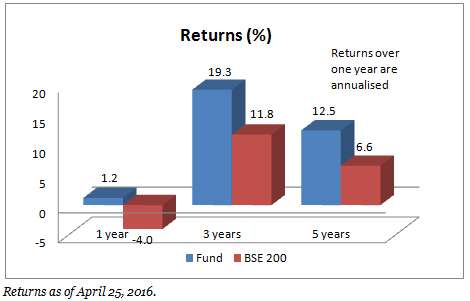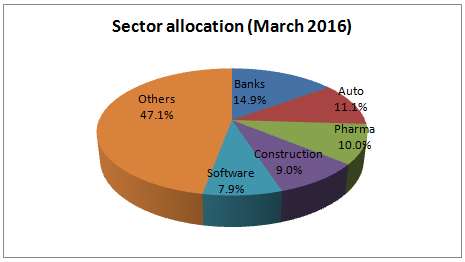Like its name suggests, Tata Equity Opportunities looks for stocks that are undervalued relative to their potential. They may be so because they are yet unnoticed by the market, or are on the verge of turning around, or which may not be clocking good growth today but can do so over the medium or long term as their fundamentals improve, and so on. To this end, it does not have a strict market cap bias, and is a diversified or multi-cap fund. However, in the past five years, it has held at least 60 per cent of its portfolio in large-cap stocks.
Tata Equity Opportunities has been slowly improving in performance over the past two years. From being a mid-quartile performer, the fund moved into the top quartile among multi-cap funds in the one-year period. Its one-year return of 1.2 per cent places it well above its benchmark BSE 200’s 4 per cent loss and its category’s 1 per cent loss.
Beating the benchmark
Against its benchmark, the BSE 200 Index, the fund scores very well. Three-year returns rolled daily over the past five years shows that the fund beat the BSE 200 Index 87 per cent of the time. Across the one, three, and five year periods, it beat the benchmark by 5 to 7 percentage points.

Where Tata Equity Opportunities falters is in its long-term track record, and its ability to do better than its peers. One, in the 2008 bear market and 2009 bull market, the fund failed to beat the BSE 200. The fund’s manager then changed in 2013. Two, in both these cycles, as well as the 2014 and 2015 markets, the fund did not match up to the category’s average return by a significant margin. The three-year rolling return over the past five years has the fund beating its category average a little over half the time. This figure, though, has been slowly improving, meriting a watch on its performance. Moreover, on other parameters, the fund does do well. Its risk-adjusted returns is better than its category. It contains volatility in returns very well too, given that it picks out-of-favour stocks.
Dark horse picks
In fact, this strategy of investing in stocks on the cusp of a re-rating or turnaround partly explains its underperformance compared to peers such as Franklin India Prima Plus and Mirae Asset India Opportunities. The Mirae fund, for example, sticks mostly to quality companies. Tata Equity Opportunities, on the other hand, has stocks such as Sadbhav Engineering, Tata Motors, State Bank of India, and so on, in its portfolio, and higher exposure to sectors such as energy, construction, cement, and engineering.
The fund cut exposure to banking to 15 per cent now in a deviation from most diversified funds. For example, the Mirae and Franklin funds had a 24-28 per cent exposure to banking. While these two funds held outperformers such as IndusInd Bank, Yes Bank, or Kotak Mahindra, Tata Equity Opportunities relied more on the poorly-performing ICICI Bank and Axis Bank. Similarly, in the auto sector that accounts for the second-heaviest sector weight, the fund upped holding in Tata Motors. This stock has only recently begun to outperform peer stocks. The fund also has higher holding in pharmaceuticals.
But its current portfolio has a decided tilt towards cyclical sectors such as those mentioned earlier. This can pay off if expectations on earnings growth and infrastructure improvement pan out. Apart from auto and telecom, the fund has limited exposure to consumer-oriented sectors given that there is limited potential for stock discovery. The fund holds a diffused portfolio, with individual stocks rarely taking up more than 5 per cent of the portfolio. Sector concentration is also not high.

As the fund tends to take calls on stocks that are not market favourites, a longer term horizon is necessary for the market to recognise the potential and push the stocks up. Well-timed picks that have paid off include Jet Airways, KNR Construction, and Shree Cement, for example. Despite its large-cap bias, therefore, the fund does require a higher risk appetite. The fund’s brightening performance makes it a good one to keep an eye on.
Improvement in consistency with regard to category average can add to its appeal as well. Pradeep Gokhale and Rupesh Patel are the fund’s managers. The fund has an AUM of Rs. 1,130 crore.
FundsIndia’s Research team has, to the best of its ability, taken into account various factors – both quantitative measures and qualitative assessments, in an unbiased manner, while choosing the fund(s) mentioned above. However, they carry unknown risks and uncertainties linked to broad markets, as well as analysts’ expectations about future events. They should not, therefore, be the sole basis of investment decisions. To know how to read our weekly fund reviews, please click here.






